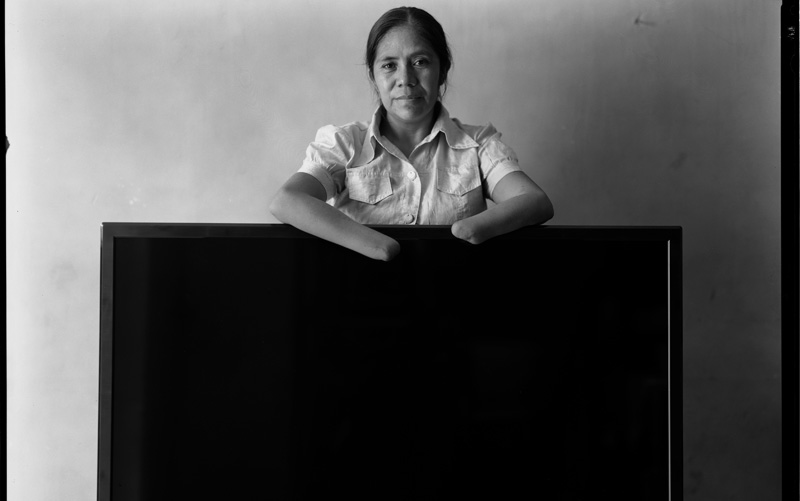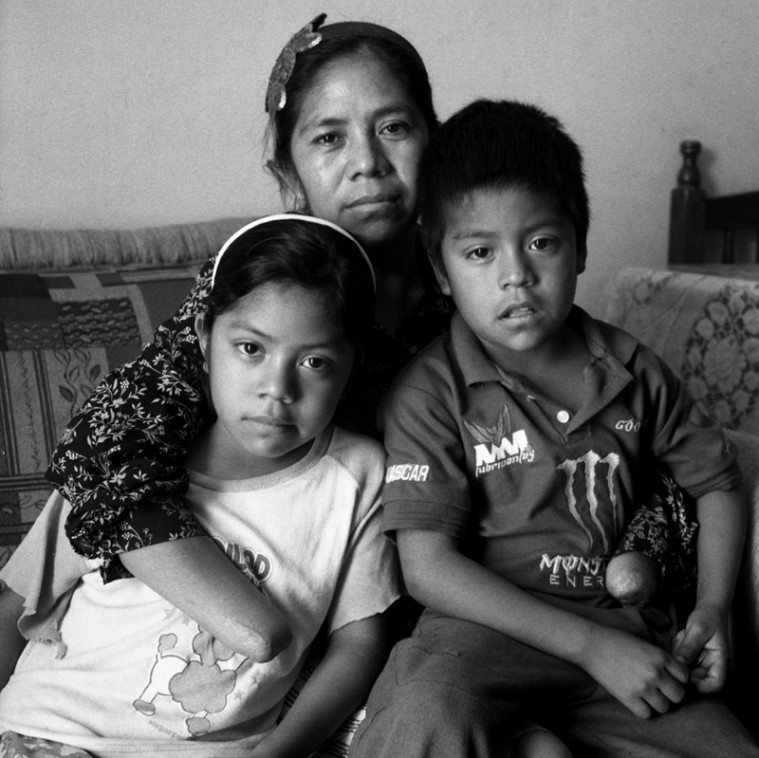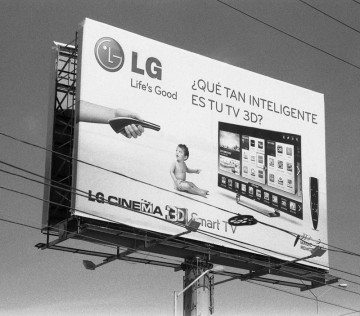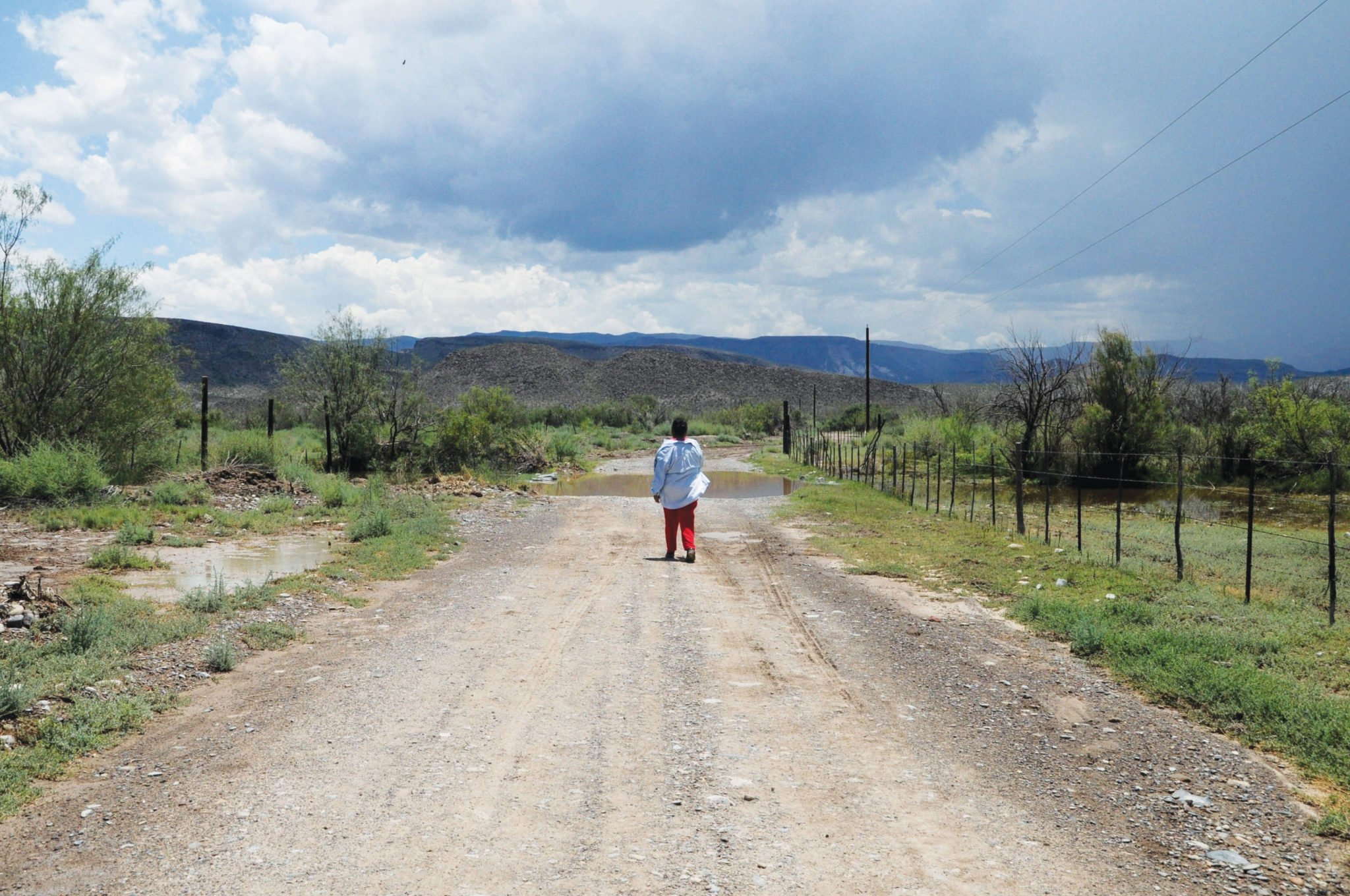
‘We Are Disposable’
Twenty years after NAFTA, the plight of Mexican maquiladora workers like Rosa Moreno has worsened.

A version of this story ran in the December 2013 issue.
Above: Rose Moreno
It was Saturday night, and, as usual, Rosa Moreno was getting ready to work the night shift at the factory.
On this night, Feb. 19, 2011, she couldn’t shake the feeling that something was wrong, a premonition that perhaps she shouldn’t go. But she needed the money. It was the final shift in her six-day workweek, and if she missed a day, the factory would dock her 300 pesos. She couldn’t afford to lose that kind of money. Her family already struggled to survive on the 1,300 pesos (about $100) a week she earned. Unable to shake the bad feeling, she’d already missed her bus, and now she’d have to pay for a taxi. But the thought of losing 300 pesos was worse. She had to go. Rosa kissed her six children goodnight and set out across town.
In the Mexican border city of Reynosa, the hundreds of maquiladoras that produce everything from car parts to flat-screen televisions run day and night—365 days a year—to feed global demand. Rosa worked from 10 p.m. to 7 a.m. at a factory called HD Electronics in a sprawling maquiladora park near the international bridge that links Reynosa, an industrial city of 600,000, to Pharr, Texas. Like the 90,000 or more workers in Reynosa, the 38-year-old Rosa depended on these factories for her livelihood. In the 11 years since she moved to the city, she had welded circuitry for Asian and European cell phone companies, assembled tubing for medical IV units to be shipped over the border to the United States, and worked on a production line assembling air conditioners for General Motors.
This was her second month at HD Electronics, a South Korean firm that had moved to Reynosa in 2006 to produce the metal backing for flat-screen televisions made by another South Korean firm, LG Electronics—a $49 billion corporation. LG also has a plant in Reynosa and could scarcely keep up with the North American demand for its plasma and LCD televisions.
At HD Electronics, Rosa operated a 200-ton hydraulic stamping press. Every night, six days a week, she fed the massive machine thin aluminum sheets. The machine ran all day, every day. Each time the press closed it sounded like a giant hammer striking metal: thwack, thwack, thwack. The metal sheets emerged pierced and molded into shape for each model and size of television. At the factory, 20 women, including Rosa, worked the presses to make the pieces for the smaller televisions. Nearby were 10 larger presses, each of which took two men to operate, to make backings for the giant-screen models.
Rosa was glad to have the work, but it was exhausting. Her husband was serving a five-year sentence in prison. She wouldn’t talk about what had put him there. Whatever happened, she was on her own. Thankfully, her two oldest were already grown and married. But she had six children still at home to clothe and feed. She especially worried about her youngest—9-year-old twins Rosita and Lencho. They had scarcely spent time with their father before he’d gone away. And now she was always at work, or tired or stressed about money.
At the plant, the line leader urged the workers to move faster. “You work without stopping because you have to reach a set goal,” Rosa said. “You can’t even go to the bathroom. And your feet start to ache and your back hurts because you’re standing in the same position the whole time.”
Complaining wouldn’t do any good. There was always another worker who would take her place. The modest labor and safety protections that workers had fought for in the 1990s, with the passage of the North American Free Trade Agreement (NAFTA), had been lost after the maquila industry was battered by the automotive crisis that began in 2000 and then the recession of 2008. Multinational corporations competing in the global economy wanted cheap, compliant labor that they could hire and fire at will. The Mexican government and the business community, not wanting to lose an important sector of the economy, did everything they could to abide by industry demands. Rosa had to comply or be replaced.
At 1 a.m., the women in her section were excused for their 30-minute break to eat. Rosa had brought tamales to share. She wasn’t happy about being moved to machine 19 but she kept her thoughts to herself. Another worker had been moving too slowly, so the line leader had moved Rosa to machine 19 to speed up production. “No one liked to work on that machine, because everyone thought it was too difficult,” she said. “But the way it works is that the person who moves the fastest is moved to wherever the material must be produced.”
After the break, Rosa returned to her station. She rolled her gray woolen gloves up to her elbows to prevent cuts from the thin metal sheets she fed into the massive press. After an hour, the line leader came by to ask Rosa how many pieces she had produced. “I said, ‘1,500 pieces,’ and he said, ‘No, you need to go faster because they need to ship these pieces by morning.’” Rosa picked up the pace. “This machine was different from the one I usually use. You had to push the piece in with both hands and make sure it was perfectly centered.” After that, she would press two buttons, one with each hand, to lower the press. “I was very concentrated, really focused on getting the work done,” she said. At approximately 2:30 a.m., Rosa was centering a piece of metal in the machine when she heard something metallic give way.
Rosa’s friend Cira Mesa was working on another machine a few feet away. “I heard a single, high-pitched scream,” she said. “I looked over, and it was Rosa. The machine had fallen on her hands.”

The difficult, often dangerous working conditions that Rosa and at least 1.3 million other Mexican workers endure in the maquiladora industry were supposed to get better. That’s what political leaders on both sides of the border had pledged in 1994 with the passage of the continent-wide trade agreement. NAFTA, it was promised, would drive up workers’ wages, improve working conditions and spur job growth, creating hundreds of thousands of new middle-class citizens on both sides of the border.
The seeds of NAFTA were cultivated in Texas during numerous discussions between Mexico’s young Harvard-trained President Carlos Salinas and President George H.W. Bush. In 1992, at a historic meeting in San Antonio, Salinas, Bush and Canadian Prime Minister Brian Mulroney posed for a photo while their top negotiators ceremoniously signed the agreement at the Plaza San Antonio Hotel.
Donate now to support independent, nonprofit journalism.The maquiladora industry was instrumental to NAFTA. Multinational corporations from developed countries like the United States and Canada could import raw materials to be assembled and manufactured at maquiladoras in free-trade zones along Mexico’s northern border. Mexico would provide the corporations with low-wage workers and charge minimal tariffs.
Maquiladoras had been Mexico’s primary economic development strategy since the late 1960s. Under the repressive one-party rule of the Revolutionary Institutional Party, or PRI, the labor unions had been largely coopted to favor the business sector. By the early 1990s, Mexican President Salinas, a member of the PRI, had become an unabashed cheerleader for NAFTA, telling Fortune magazine the agreement would “Create additional jobs and make wages grow. …If we do not create additional jobs in Mexico, Mexicans will merely walk across the border looking for jobs in the north.”
But NAFTA also had its detractors. U.S. labor unions, environmentalists, human-rights advocates and other opponents on both sides of the border predicted the loss of American manufacturing jobs and deteriorating conditions for Mexican workers. Mexico, with its lax pollution regulations and labor enforcement, would become a magnet for multinational corporations looking to cut costs, critics argued. The debate polarized both countries. During a 1992 presidential debate, independent candidate and billionaire Ross Perot struck a chord with many critics when he described U.S. job losses to Mexico under NAFTA as “a giant sucking sound going south.”
In early 1993, newly elected President Bill Clinton, under pressure from labor unions and other critics, pledged to re-open negotiations on NAFTA, promising better labor and environmental protections. Again Texas played a crucial role. A frustrated President Salinas, who had spent three years negotiating the agreement with Bush, hastily requested a meeting with the president-elect, according to Maxwell A. Cameron and Brian Tomlin in their book The Making of NAFTA: How the Deal Was Done. Not officially president yet, Clinton couldn’t meet with Salinas on Mexican soil. With the help of Texas Gov. Ann Richards, they met in Austin to discuss changes to NAFTA that would include more protections for workers. NAFTA was ratified in 1994.
President Clinton praised the agreement’s benefits for workers. “There will be an even more rapid closing of the gap between our two wage rates,” he said. “And as the benefits of economic growth are spread in Mexico to working people, what will happen? They’ll have more disposable income to buy more American products, and there will be less illegal immigration because more Mexicans will be able to support their children by staying home.”
Clinton estimated NAFTA would produce 200,000 new jobs in the United States within the first two years. Salinas had similar glowing predictions. There were some positive economic indicators. Foreign direct investment in Mexico surged, and the country’s exports tripled. Meanwhile, Americans found they could buy imported goods more cheaply.
But for workers on both sides of the border, especially those without a college degree, NAFTA was a devastating blow. The great “sucking sound to the south,” as Perot had so bluntly put it, had begun. Between 1994 and 2010, nearly 683,000 U.S. jobs were lost—the majority of them in manufacturing, according to a study on NAFTA by the progressive Economic Policy Institute. Workers from the higher-paid manufacturing sectors in the U.S. were forced to take lower-wage service industry jobs, losing retirement and health-insurance benefits.
In Mexico, the number of foreign-owned maquiladoras doubled, but government policies kept wages from increasing. Meanwhile, cheap U.S.-subsidized corn flooded the Mexican market, putting small farmers out of business and forcing them to leave their towns for larger urban centers in search of work. Mexico’s economy grew at a sluggish annual per capita rate of just 1.6 percent between 1992 and 2007—one of the lowest rates in Latin America, according to the Carnegie Endowment for International Peace.
Very little of the wealth generated by the maquiladoras was invested into Mexican society to alleviate poverty. The global economy favored a few. In 2010 Forbes magazine named its first Mexican citizen, Carlos Slim, as the world’s richest man. Yet 45 percent of the Mexican population lived in poverty, according to government figures.
Like many, Rosa was struggling to put food on the table. Working six days a week she took home 5,200 pesos a month, about $400. To make a little extra money, she also sold cosmetics and face creams. In Reynosa, like other border cities, the cost of living wasn’t cheap. Food in the supermarkets cost as much as it did in the United States. The public elementary school in Rosa’s poor, working-class neighborhood was so overcrowded it divided the school day into two shifts. Her 9-year-old twins Rosita and Lencho waited until the morning shift was over so they could attend school in the afternoon. Rosa and other parents were expected to pay a registration fee, and for books and uniforms. The mortgage on her tiny two-bedroom home wasn’t cheap, either. Every month she paid 2,500 pesos, nearly half her monthly income, for her concrete-block home on a dusty side street.

At the same time, life in Reynosa was becoming more dangerous. In 2006, the government launched a military campaign against drug cartels and violence exploded, especially in working-class neighborhoods like Rosa’s. It wasn’t unusual for cartel gunmen to hijack the buses taking workers to the factories and use them to blockade the roads during gun battles with the military or a rival cartel. Workers were sometimes killed in the crossfire. Working night shifts was especially dangerous because the gunmen were most active at night. Foreign owners and upper-level managers of the maquiladoras curtailed their own travel to the city, holding management meetings across the river in Texas, where many of them lived. The inequality gap now had a new dimension involving personal safety: Upper management stayed on the U.S. side of the border and away from the weekly gun battles, while the workers remained to run the factories—and dodge the bullets.
Working the night shift, Rosa at least felt better that her children were at home asleep while she worked and not on the streets. She knew it was dangerous to leave for work late at night to take a bus across the city. But she always felt safe once she reached the factory.

Jose Olmos was working one of the large stamping presses when he heard the screams. By the time he got to Rosa, “some of the women had fainted,” he said. “But Rosa just stood there silent. I imagine she was in shock. A maintenance man was pressing the buttons, trying to get the hydraulic press to open.”
“It felt like I had plunged my hands into boiling water—they were burning,” Rosa said, her words tumbling out quickly as she relived the accident. “I tried to control myself so that I didn’t panic or get too scared. My biggest fear was that if I lost consciousness, I wouldn’t know where they’d leave me. I thank God. He’s the one that helped me stay conscious. It was my faith that pulled me through.”
It was well known among workers in Reynosa that the maquiladora bosses didn’t like sending injured employees to the government social security hospitals, where physicians were required by law to report workplace accidents. This would mean that the offending maquiladoras would have to pay more into the government’s social security system. It wasn’t uncommon for a worker with serious injuries to be offered first aid at the factory or be driven to a private clinic rather than be taken directly to the nearest hospital.
Ten minutes had already passed when Olmos and a few of the other men struck upon the idea of creating a makeshift jack. Using a steel pole, they pried the press open just enough for Rosa to pull out her hands. “I’ve seen many things in my life,” Olmos said, his voice lowering. “But this really had an impact on me.”
“I wasn’t bleeding very much because the press had actually forged the ends of my arms to the metal sheet,” Rosa said. “The piece was attached to my hands. I remember saying, ‘Take the piece off. Take it off.’ But they didn’t want to.”
The factory nurse came running. She covered Rosa’s hands with a white sheet. Again, some of the women fainted. The metallic clanging of the presses in their area had fallen silent, but in the rest of the factory, people kept working to meet their production quotas. “The nurse said I needed to be taken to the infirmary, but I asked what could she possibly do for me there?”
Two of the workers ran to get a stretcher. One of the men said he would drive Rosa to the social security hospital himself. “In the car, the nurse told me they’d take me to the general hospital or to the Red Cross, but I told her no,” Rosa said. “Like the other workers, I paid into the social security system, and I wanted to be taken to the social security hospital. She was very annoyed with me. But I insisted.”
At the government hospital, Rosa steeled herself for the worst. She knew her hands were destroyed and would have to be amputated. She was already thinking about the future, playing through the various crises that would unfold if she couldn’t work. She knew intimately what hunger felt like. That was why 11 years ago, she’d brought her children from the State of Mexico, in the center of the country, to Reynosa, traveling nearly 700 miles by bus so that she could work in the maquiladoras so her family would never go hungry again.
While Rosa was in the hospital, Cira went back to HD Electronics to try to discover what had caused the accident. At the factory, the general manager told Cira and the other workers that Rosa was at fault because she’d been too tired and wasn’t paying attention. But the machine had safety mechanisms to prevent accidents like the one Rosa had suffered. A worker had to press two buttons simultaneously to lower the press. This ensured that a worker didn’t have her hands inside the machine when the 200-ton press came down. Cira said she spoke to a maintenance man at the factory who confided to her that machine 19 hadn’t been properly maintained for months because taking it offline would slow production. Cira said she begged the man to come forward and testify on Rosa’s behalf, but he was too afraid of losing his job.
Five days after the accident, the bills were piling up at home. Rosa checked herself out of the hospital and went directly to HD Electronics to speak with the manager. He seemed shocked to see her in his office, her mutilated arms wrapped in white bandages. “He said, ‘Señora, why don’t you go home and rest.’ I said, ‘No, I want to have a meeting because you need to give me compensation. How will I feed my children?’”
The general manager said the company could offer her 50,000 pesos, approximately $3,800 in U.S. dollars, as a settlement. “I told him, ‘I’m not going to accept that. I’ve lost both of my hands, how will my family survive on 50,000 pesos?’”
“That’s our offer,” the general manager said, according to Rosa. “Stop making such a big scandal about it and take it. It will help your family.”
But she refused. As a single parent, she had to do better for her family than 50,000 pesos. But the law wasn’t on her side. Mexico’s federal labor law mandates that the loss of each hand was worth 75 percent of two years’ wages. Rosa made $4,800 a year. That meant under the law her settlement should be about $14,400, much higher than what the company was offering but scarcely enough to replace a lifetime of lost wages.
Undeterred, Rosa, accompanied by Cira, set out to find a lawyer who would advocate for her in a settlement. They went from one law office to the next in Reynosa but were turned down by every attorney they spoke with. The two women, through another worker, learned that an employee at HD Electronics had been crushed to death in one of the larger presses two years earlier and his family had taken a settlement of 150,000 pesos, approximately $11,538. “The lawyers advised me to take the money because it was all they were required to pay under the law,” Rosa said.
There was also confusion about which company was responsible for Rosa’s compensation. In the past decade, many maquiladoras have outsourced labor contracting to outside companies to cut costs. These labor recruiters are charged with keeping the factories stocked with an unending supply of workers who will work without complaint no matter the conditions.
In the past dozen years, working conditions in maquiladoras have worsened. In 2000, foreign–owned companies began leaving Mexico and moving to China, where the average monthly wage for a factory worker is $160—less than half the wage of a Mexican worker. At least 200,000 Mexican workers lost their jobs, the majority of them in border cities like Reynosa.
Those still on the payroll were given more tasks and expected to work faster. A normal workweek became 48 hours, which is legal under Mexico’s labor laws. Eventually, companies began to return. Wages in China had quadrupled to bolster the emerging Chinese middle class, while Mexico’s wages had stagnated. Asian companies began to view Mexico’s northern border, with its infrastructure already in place, low tariffs and a skilled low-wage workforce, as a desirable location for expanding their market share in North America.
In 2006, HD Electronics moved from South Korea to Reynosa to service its main client, LG Electronics. LG had acquired the formerly U.S.-owned Zenith plant in Reynosa in 2000, launching its “Life’s Good” campaign in North America. The world’s second-largest supplier of liquid crystal and plasma televisions, LG announced in 2012 that its Reynosa factory made $2.5 billion in sales in the North American market. This year it plans to earn $3 billion.
Like most factory workers, Rosa was employed under temporary contracts with a local labor-staffing agency rather than as a full-time employee of the factory, where she might have received benefits. At the time of her accident, Rosa was an employee of neither HD Electronics nor LG Electronics. She was actually an employee of a Reynosa-based employment agency called Human Resources.
The owner of Human Resources declined to comment for this story. After I left several messages at the office of HD Electronics in Reynosa, Antonio Zapata, a human resources manager, said his company had no comment about Rosa’s case.
It’s unclear what corporate relationship, if any, there is between HD Electronics and LG Electronics. On HD’s website, LG Electronics is listed as its only client. John Taylor, vice president of LG Electronics USA, Inc., said HD Electronics is not a subsidiary of LG. “It is a separate company. One of the tens of thousands of LG’s vendors around the world,” Taylor wrote in an email.
Trying to navigate the various corporate entities was difficult. So Cira suggested Rosa go to the union for help. Every maquiladora worker is required to join a union and pay dues. The Industrial Union of Workers in Maquiladora Plants of Reynosa represented Rosa and other workers at HD Electronics. But when the two women arrived at the union office, they received little welcome. Cira said, “A man told us, ‘The person in charge is not here, what do you want?’ I said, ‘Don’t you have eyes? Can’t you see the person standing next to me?’” The man seemed unmoved by Rosa’s plight, Cira said. So the women left in disgust.
Rosa decided to try one more lawyer, who advertised around the city and had an upscale office in the nicer part of Reynosa. Again, Cira accompanied Rosa for moral support. “This was when I really lost faith,” Cira said. “This lawyer in his fancy office told Rosa, ‘You know what you should do, señora? Go up to the international bridge and put a cup out and people will help you. With your injuries you’ll make a lot of money.’” Cira’s face turned red remembering the meeting. Rosa stared at the floor. She couldn’t talk about it. “I couldn’t eat all day after that I was so upset,” Cira said. “I couldn’t imagine how anyone could say something like that.”
It was time to do something drastic. Cira convinced Rosa to call the local television station. A reporter came to Rosa’s house and interviewed her on camera about the accident. Other reporters followed, and the story got significant airplay in northern Mexico. The morning after Rosa’s first interview aired, an attorney from Human Resources arrived at her home. According to Rosa, the woman was upset with her portrayal of the factory and Human Resources. “Why did you go on television and tell lies about us?” the woman asked, according to Rosa. “Now, we’ll lose clients. We’ve made you an offer for a settlement, and we won’t offer another peso more.” Rosa declined the monetary settlement, but accepted the company’s offer of prosthetic hooks. Rosa sent her measurements to Monterrey and anxiously awaited their arrival. But when they came, the cheap prosthetics were too heavy and unwieldy to use, she said. “I would get so tired trying to make them work, and they would make my shoulders hurt, so I stopped using them.”

The night Rosa’s story aired on television, Paulina Hernandez, a maquiladora worker and longtime labor-rights activist, saw it, and vowed to find Rosa and help her. Hernandez is one of nine promotoras, or social workers, in Tamaulipas who works for the nonprofit Comite de Apoyo (Committee of Help) to educate maquila workers about labor laws and their rights. Ed Krueger, a retired minister from the Rio Grande Valley, worked with the Quaker organization American Friends Service Committee to create the nonprofit in 1980. Now retired, the 82-year-old still visits Reynosa and neighboring Rio Bravo, dodging potholes and muffler-mangling speed bumps in his battered Ford Escort. Anyone who knows Krueger compares his easy affability to Mister Rogers, but with an iron will to get things done no matter the obstacle. Back in the 1980s, Krueger had been so effective at educating laborers about their rights, he’d received threats from corrupt union bosses and felt it prudent to stay out of Reynosa for nearly a decade. But in recent years he has resumed his regular visits. Even after gun battles erupted in Reynosa in 2010 among drug cartels and the military, and a number of Mexican reporters were kidnapped and killed and most Americans stopped crossing the border, Krueger wouldn’t stay away.
After Hernandez tracked down Rosa, she immediately called Krueger. He set about finding people who might help. I found Rosa through Austin photographer Alan Pogue, a longtime friend of Krueger.
In September, I accompanied Krueger to visit Rosa. As we drove up to a military checkpoint in Reynosa in Krueger’s Ford, he smiled and waved cheerily at the group of soldiers wearing dark sunglasses and draped in assault rifles. They waved us through with scarcely a glance.
Krueger is trying to raise money to bring Rosa to Texas, where she could be fitted for high-tech prosthetic hands that would allow her to support her family again. Meanwhile, unable to find anyone in Mexico who would represent her, Rosa filed a lawsuit in U.S. court against LG Electronics, Inc. John Taylor, spokesperson for LG, said in an email that there was no basis for the lawsuit.
“Ms. Moreno’s injuries were tragic, and LG Electronics extends its sympathies to Ms. Moreno and her family. At the same time I want to emphasize that in no way did LG Electronics cause or contribute to Ms. Moreno’s injuries, and LG Electronics bears no responsibility for them. LG Electronics had no control over the machine that apparently malfunctioned and caused Ms. Moreno’s injuries. All that LG Electronics did was to purchase a part manufactured by [HD Electronics].”
The lawsuit is pending. These days Rosa receives the equivalent of $200 a month in government disability benefits. It has been nearly three years since she lost her hands. When I met with Rosa in September, her house was about to be repossessed. She couldn’t make the monthly payments on the tiny cinder-block home she and her husband had taken a mortgage on through the government-run Infonavit housing program. She worried she might end up on the streets soon, a cup in front of her, just as the lawyer had suggested.
She has little recourse. The NAFTA side agreement negotiated by Salinas and Clinton to protect workers 20 years ago never panned out. Under the agreement, workers, like Rosa, with grievances can request a hearing at a government entity called the National Administrative Office. From there, the complaint is sent to the respective country’s labor secretary for further consultation and eventually resolution.
But the system was set up to fail, according to NAFTA’s many critics. The handful of cases submitted were never resolved. A decade after NAFTA took effect, the UCLA Center for Labor, Research and Education found workers were already abandoning the process. “They are disillusioned and frustrated by the weak outcomes of ministerial consultations and the governments’ refusal to pursue even the best-documented cases,” the center concluded. Rosa, Paulina Hernandez and nearly a dozen other maquiladora workers I spoke with weren’t even aware that a grievance process through NAFTA existed.
There’s no shortage of need. Having spent more than 30 years advocating for workers’ rights, Hernandez emphasized that what happened to Rosa isn’t unique; what makes Rosa different is her tenacity and willingness to speak out publicly. In three decades, Hernandez had seen dozens of illnesses, injuries and even deaths. Seldom had she seen a worker receive adequate compensation or government officials crack down on worker-safety violations. Maquiladoras wanting to protect the bottom line often underreport workplace injuries and fatalities so it’s difficult to get an idea of the true scope of the problem. In 2011, the year Rosa had her accident, the Mexican Social Security Institute, which oversees the government-run hospitals, reported just 17,302 workplace accidents. Advocates say that is likely a gross undercount. That same year, the United States, albeit with three times the population of Mexico, reported 2.8 million workplace accidents.
After visiting with Rosa, Krueger and I drove to the neighboring town of Rio Bravo. We arrived at a semi-desolate neighborhood of Infonavit-funded homes in the middle of a former sorghum field where many maquiladora workers live. Maquiladoras pay 5 percent of their payroll taxes into Infonavit, the Spanish acronym for the Institute for the National Fund for Employee Housing, to help workers buy homes. But the agency has become infamous in Mexico for shoddy housing, cronyism and an inflexible bureaucracy.
The recently built rows of identical concrete homes felt impermanent and at the same time hopeful. It was an improvement over the makeshift shantytowns so many workers lived in on the outskirts of the city. But the neighborhood was a microcosm of the problems currently afflicting Mexico. Some homes were boarded up or had for-sale signs in the front windows advertising rock-bottom prices. Their former owners had lost their jobs and, unable to pay their mortgages, abandoned their homes. The families who remained—most of them first-time homebuyers—had painted their homes in hopeful blues or vibrant greens and planted decorative trees in front, trying to make the most of it.
But at the entrance to the neighborhood, men hawked black-market gasoline stolen from the government-owned oil monopoly from a flatbed truck. And nearby, state police armed with high-caliber assault rifles had set up a roadblock and were randomly stopping vehicles, especially those containing young men, pulling them out of their cars to be searched and sometimes detained.
In the living room of a bright-green house with a sparkling tile floor, we met with some of the other Comite de Apoyo promotoras and seven of their fellow maquiladora workers. One woman had her arm in a sling. She told me she was in acute pain after years of working in a U.S.-owned wheelchair factory and would have to have surgery, but the maquiladora wouldn’t acknowledge her injury as work-related. Another man had been exposed to dangerous solvents for years and had not been given any protective equipment. A man in a red baseball hat was so furious about the union’s refusal to help him in a work-related dispute that he spoke in rapid-fire bursts as if he might explode. During their years working in the maquiladoras, they told me, they’d seen numerous accidents, even deaths, and the conditions for workers were deteriorating.
“It’s our own government that has sold us out,” said the husband of the woman with the sling. His wife, like the other women at the meeting, seemed to be taking her difficulties in stride, but her husband, like the man in the red cap, could barely contain his rage. “They’re enslaving us,” he said. “But what can we do? We have to eat. When we get hurt, they forget us. We are disposable.”
Afterward, on the way back to the international bridge, we stopped at a red light near Rosa’s house. Between the idling cars, a middle-aged man with no legs propping himself up on makeshift crutches held out a cup for change. Another man, who looked to be in his mid-20s, hobbled up to the car on his one leg and offered his outstretched hand. The light turned green, and a cacophony of car horns erupted. The young man stared blankly as the cars passed him by.
Alan Pogue’s work, including the photos in this story, is currently on display at La Peña Gallery as part of “Alan Pogue: A 46-Year Retrospective of Peace & Justice Photography.” For more information, visit www.lapena-austin.org.
A fund has been established to help Rosa Moreno. You can make a donation here.
To support journalism like this, donate to the Texas Observer.

